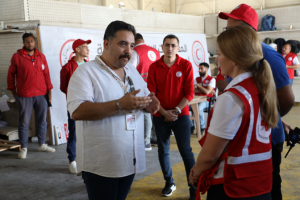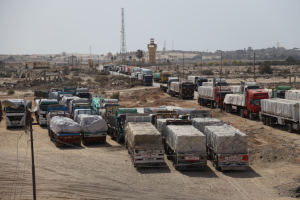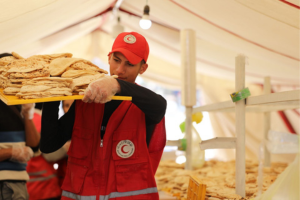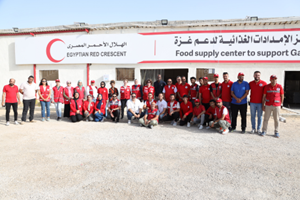I’m in Al-Arish, Egypt, the last town before you reach the Rafah border crossing, which separates Egypt and Gaza. On the day I visit, it has been 16 days since humanitarian aid has been let through the crossing and there are trucks with humanitarian cargo as far as the eye can see. It’s easy to wonder what will happen when the border opens – what’s the order? Who gets in first?
The answer lies with the Egyptian Red Crescent, who has been coordinating all humanitarian aid crossing from Egypt into Gaza since the escalation of conflict in October 2023. I’m in Egypt to visit their logistics hub warehouse and learn more about the support they are providing in both Gaza and Egypt to people impacted by the ongoing conflict.
The Egyptian Red Crescent isn’t just supporting humanitarian aid logistics, although this has become a key focus of their response. They’re also supporting medical evacuees from Gaza and their families who are staying in Egypt, working with the Palestine Red Crescent Society to run camps for displaced people in Gaza and distributing food parcels, hot meals and bread. The response is supported by thousands of dedicated staff and volunteers, often working around the clock to ensure people have the help they need.
Logistics as a lifeline
Getting enough humanitarian aid into Gaza has been an enormous challenge since the escalation of conflict. Aid had been increasing in the weeks leading up to May 6, but the border closure has led to a backlog of trucks, with approximately 2,900 waiting to be let through as of May 22. The backlog continues to grow too, with new aid coming in daily via air, land, and sea from around the world.
 Egyptian Red Crescent personnel handle almost every aspect of coordinating humanitarian aid for all humanitarian organizations – not just the Red Cross and Red Crescent Movement – from the time it arrives in Egypt to when it crosses into Gaza. I’m shown around the logistics warehouse by Lotfy Gheith, Egyptian Red Crescent head of operations. He tells us that their logistics warehouse is staffed 24 hours a day and outlines how the humanitarian aid is handled, with personnel receiving and packaging it, contracting truck drivers and tracking where the shipments are in their journey.
Egyptian Red Crescent personnel handle almost every aspect of coordinating humanitarian aid for all humanitarian organizations – not just the Red Cross and Red Crescent Movement – from the time it arrives in Egypt to when it crosses into Gaza. I’m shown around the logistics warehouse by Lotfy Gheith, Egyptian Red Crescent head of operations. He tells us that their logistics warehouse is staffed 24 hours a day and outlines how the humanitarian aid is handled, with personnel receiving and packaging it, contracting truck drivers and tracking where the shipments are in their journey.It’s an immensely complicated operation, especially for an organization that just started doing large-scale logistics eight months ago. In addition to the backlog of humanitarian aid, some common items such as tents with pegs, certain power generators, kitchen sets with knives, and children’s toys in metal boxes are not allowed to cross the border. This means if any of these items are in shipments, the entire truck is turned back. With no clear list of items that are approved or denied entry, aid is being further delayed in reaching the people who need it most.
 Since the work all happens behind the scenes, before the humanitarian aid reaches Gaza, it’s easy to overlook the importance of it. Seeing the tireless work of Egyptian Red Crescent personnel first-hand, sorting pallets of humanitarian aid in extremely hot weather, it’s clear they see the importance of what they’re doing. “Volunteers are working here in the hot weather, and in the very cold weather when we started in October and November,” Dr. Amal Emam, acting CEO of Egyptian Red Crescent tells me. “They have never stopped…giving from their hearts.”
Since the work all happens behind the scenes, before the humanitarian aid reaches Gaza, it’s easy to overlook the importance of it. Seeing the tireless work of Egyptian Red Crescent personnel first-hand, sorting pallets of humanitarian aid in extremely hot weather, it’s clear they see the importance of what they’re doing. “Volunteers are working here in the hot weather, and in the very cold weather when we started in October and November,” Dr. Amal Emam, acting CEO of Egyptian Red Crescent tells me. “They have never stopped…giving from their hearts.”The same can be said for supporting the truck drivers waiting to transport aid across the border. Drivers must stay with their shipments, often waiting days (or weeks as is the case right now) in increasingly hot weather to cross into Gaza. This means they can’t leave their trucks to get food or use the bathroom, and they have no timeline for when they will be able to return home.
Egyptian Red Crescent personnel have been providing truck drivers with meals and are operating a primary health-care clinic that can help meet any basic health needs the drivers have. As we pass through a staging area for trucks near the border, we also see Egyptian Red Crescent personnel sitting with trucks so the drivers can leave their trucks for a few minutes.
It’s devastating to think of all the humanitarian aid stuck at this border crossing, while people in Gaza continue to struggle to meet their most basic needs. It’s imperative that Rafah border crossing be reopened and sufficient humanitarian aid be permitted to enter Gaza going forward.
Support to medical evacuees
While in Al-Arish, we also had the opportunity to visit a hospital where people who have been evacuated from Gaza receive medical care. The Government of Egypt is coordinating bringing people with complex cases that can’t be treated in Gaza to Egypt, with Egyptian Red Crescent providing support to them and their families. There are currently around 3,300 medical evacuees in Egypt, with about 6,000 family members accompanying them.
While fortunate to be receiving the healthcare they need, these families also face the daunting prospect of not knowing if or when they’ll be able to return home. It’s difficult to receive updates and connect with family in Gaza, as internet connectivity is spotty at best and at times, non-existent. It’s a “so close, yet so far” situation; Al-Arish has been spared from the ongoing hostilities yet is close enough to Gaza that you can sometimes hear airstrikes and see clouds of black smoke.
The first place we visit is a child-friendly space, where children whose family members are receiving medical care have the opportunity sing, draw, and laugh, even if just for a few minutes. In working with the children, the volunteers keep an eye out for signs that a child may require additional support, in which case they can refer them for more specialized mental health support. Some of the children showed us their art, featuring beloved family members and memories of their homes and communities in Gaza.
We also meet a few of the patients receiving medical care here. One older woman who has two broken legs is here with her daughter. Two young girls from Gaza share a room – one has cerebral palsy, and the other is waiting for a lung transplant and requires a steady flow of oxygen. Some patients will stay at this hospital to receive treatment, while others will be transferred on to other hospitals in Egypt or abroad to receive the care they need.
In addition to their work at the child-friendly space, Egyptian Red Crescent volunteers are also providing hot meals to evacuees and their families, items to furnish their temporary homes in Egypt, and cash assistance. It’s vital assistance for families coping with a loved one’s illness while being displaced.
“A message of love”
A few kilometres down the road, Mostafa Refaat lights up when he talks about the Humanitarian Kitchen, where Egyptian Red Crescent personnel prepare warm meals, bread, and food parcels for people from Gaza. “It’s not about bread, it’s a message of hope,” he tells us. “A message of love.”
It’s also an impressive operation, considering Egyptian Red Crescent only started providing food support a few months ago. They began in January 2024 and provided food support during Ramadan in March, working with the Palestine Red Crescent Society to deliver hot meals in camps for displaced people, as well as other locations in both Rafah and Khan Younis. The team was providing 7,000 to 15,000 meals and about 60,000 loaves of bread daily during this peak, working 24 hours a day.
 Since then, they’ve had to scale back the food assistance and focus on quality control, food safety, and temperature control for shipping meals. While they’re still giving hot meals to truck drivers and medical evacuees in Egypt, their support in Gaza has shifted to food parcels and freeze-dried meals that are non-perishable and easier to transport.
Since then, they’ve had to scale back the food assistance and focus on quality control, food safety, and temperature control for shipping meals. While they’re still giving hot meals to truck drivers and medical evacuees in Egypt, their support in Gaza has shifted to food parcels and freeze-dried meals that are non-perishable and easier to transport.It’s evident there’s a connection the Egyptian Red Crescent has with their neighbours in Gaza. In addition to working with nutrition experts to ensure the food meets dietary needs, teams are also trying to ensure the food tastes like home. “Here in…North Sinai, we have the same traditional way of preparing food as Gaza and Rafah,” Mostafa tells us. “It’s not just about rice and meat, there’s a smell” that makes the two cuisines similar.
Mostafa and his team hope to increase their support to the levels seen during Ramadan, and are continuing to work to find the safest, most effective way to transport meals into Gaza.
Volunteers at the heart of what we do
Volunteers are at the heart of the work the Red Cross Red Crescent Movement does, and the Egyptian Red Crescent is no different. Time and again on my trip, I meet volunteers who are so motivated to help their neighbours in Gaza.
 In Cairo, we meet two Egyptian Red Crescent volunteers who are refugees themselves packing food parcels for Gaza. Ruba is Palestinian and arrived in Egypt two years ago. Riham is Sudanese and arrived about a year ago; having received support from Egyptian Red Crescent volunteers when she arrived, she decided to volunteer herself. She now calls her fellow volunteers her family.
In Cairo, we meet two Egyptian Red Crescent volunteers who are refugees themselves packing food parcels for Gaza. Ruba is Palestinian and arrived in Egypt two years ago. Riham is Sudanese and arrived about a year ago; having received support from Egyptian Red Crescent volunteers when she arrived, she decided to volunteer herself. She now calls her fellow volunteers her family.Meeting these dedicated volunteers also reminds me of the colleagues we have lost over the past eight months of this conflict. As of May 30, 24 Red Cross Red Crescent Movement colleagues have been killed while conducting their humanitarian duties. Humanitarian workers must be protected and permitted to carry out their life-saving work.
I’m grateful to the Red Cross Red Crescent Movement volunteers who continue to support the people in their communities, often at great personal risk to themselves. Whether in Egypt, Gaza or Israel, our dedicated teams are giving their all to ensure people receive the support they need.

